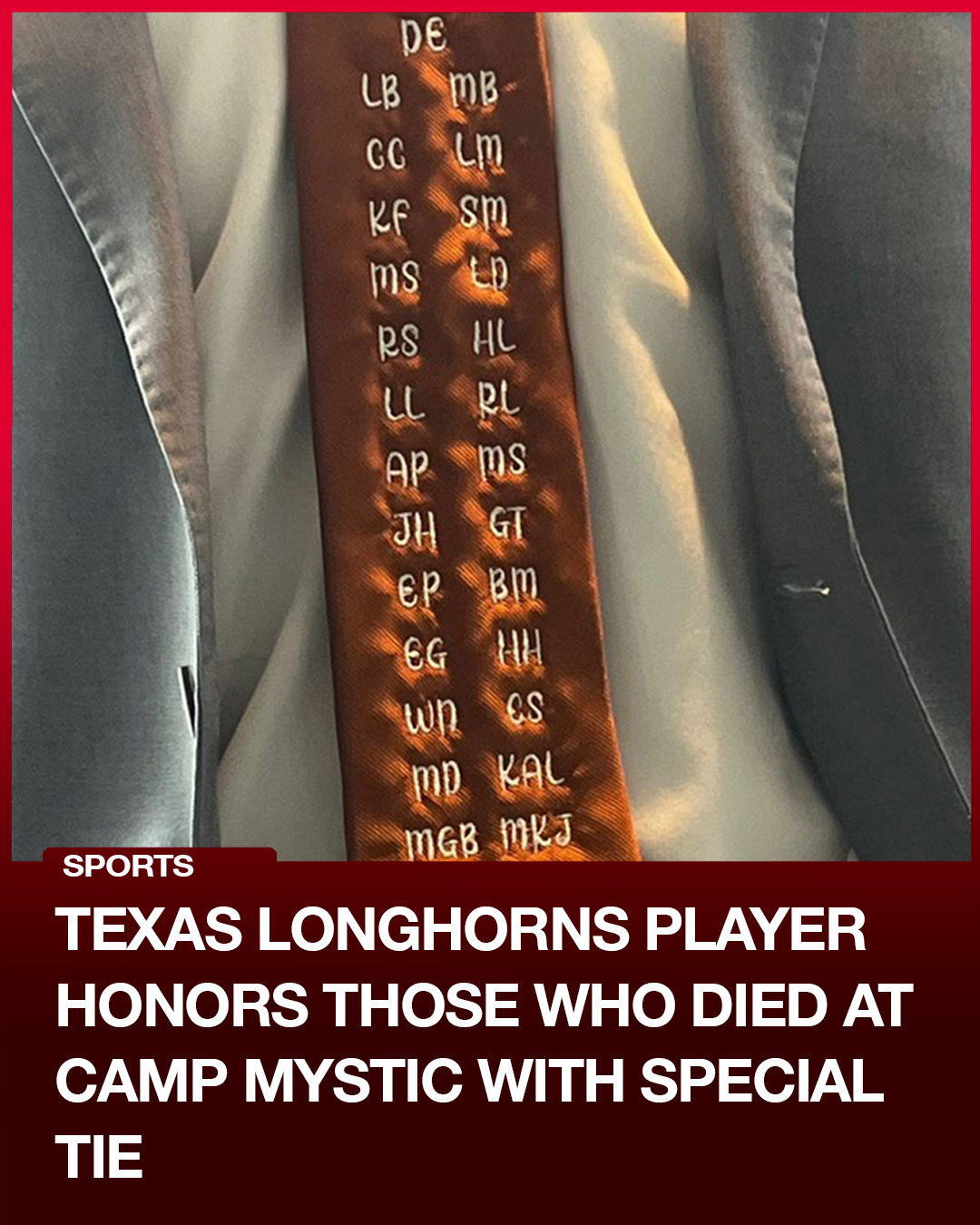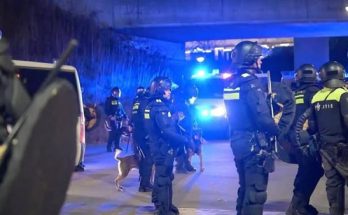Michael Taaffe, a defensive back for the Texas Longhorns, made a quiet yet powerful statement at SEC Media Days by wearing a distinctive tie adorned with 27 sets of initials. Each set represented a life lost during the catastrophic flooding that swept through Camp Mystic in the Texas Hill Country over the July 4 weekend. What might have seemed like a small gesture on a football stage carried deep meaning, connecting a prominent athlete to a devastating tragedy that shook a community and captured the nation’s attention.
The flooding that overwhelmed Camp Mystic was one of the deadliest flash floods in recent Texas history, a sudden and violent force of nature that took 27 lives at the camp alone. Among the victims were 25 young girls attending the camp, two counselors, and the camp’s executive director, Richard “Dick” Eastland. Their initials, painstakingly embroidered on Taaffe’s tie, served as a somber tribute to those whose futures were tragically cut short. The tie became a symbol of remembrance and a call for awareness, inviting everyone who saw it to remember that behind every initial was a person—a story, a family, and a community left grappling with loss.
Camp Mystic is nestled along the Guadalupe River in the Texas Hill Country, an area known for its natural beauty but also its vulnerability to flash flooding. On the night of July 3 and early hours of July 4, heavy rains fell relentlessly, with more than six inches accumulating in just a few hours. This intense rainfall caused the Guadalupe River to rise abruptly—over 20 feet in less than an hour—transforming a peaceful summer camp into a scene of chaos and destruction. The flooding was so sudden that many were caught unaware as water rushed through the camp’s cabins and grounds, sweeping away anything in its path.
Despite the National Weather Service issuing a flash flood warning in the early hours of July 4, evacuation efforts at Camp Mystic were delayed, a factor that has since come under intense scrutiny. Some have criticized the response time, noting that by the time action was taken, the floodwaters had already surged to dangerous heights. Questions about emergency preparedness, floodplain management, and warning systems have become central to ongoing investigations into what went wrong that night. One point of concern is that in 2013, FEMA removed several buildings at Camp Mystic from designated floodplain maps, potentially contributing to a false sense of security among those responsible for camp operations.
The tragedy’s human toll is staggering. The 27 individuals who perished include children as young as eight years old, many of whom were from families across Texas and beyond. Their lives were full of promise, filled with the joys of childhood and summer camp experiences—horseback riding, swimming, friendship, and faith-based learning. Stories of the victims have since emerged, painting a picture of vibrant young lives frozen in time by the floodwaters. The counselors who died showed remarkable courage, trying to shepherd the campers to safety as the flood struck. Director Richard Eastland is remembered as a hero who sacrificed his life attempting to save others during the disaster.
Michael Taaffe, raised in Austin and a former walk-on at Texas, has personal ties to the community deeply affected by the tragedy. His decision to wear the tie at SEC Media Days was not merely symbolic but a heartfelt tribute to the victims and their families. At a media event often filled with bravado and athletic hype, his gesture brought the harsh reality of the flood’s impact into sharp focus. He used the platform to remind fans and journalists alike that while football is important to many, there are moments when life demands greater attention and compassion.
The tie itself was created by an Austin-based boutique, Anderson Parker, which donated the work free of charge. The boutique later launched a fundraising effort to support flood relief efforts, raising tens of thousands of dollars for local families and organizations coping with the aftermath. The gesture by Taaffe and the community around him illustrates how sports figures and local businesses can mobilize quickly to offer tangible support in times of crisis, turning mourning into meaningful action.
Taaffe’s words when asked about the tie underscored the gravity behind his choice. He emphasized that the initials represented daughters, counselors, and the camp director who went back into the flood to try to save lives. His reminder that “football is cool, but this is real life” resonated with many, grounding the spectacle of sports in the sobering realities facing communities affected by natural disasters.
The disaster at Camp Mystic is part of a broader pattern of increasingly severe weather events that have challenged communities in Texas and across the country. As climate change accelerates, scientists warn that flash flooding and extreme rainfall will become more frequent, posing ongoing risks to vulnerable populations. The tragedy has reignited debates about emergency management protocols, infrastructure investment, and environmental policies designed to mitigate such disasters.
Families of the victims have expressed a mix of grief, anger, and a desire for accountability. There are calls for thorough investigations into the camp’s evacuation procedures, the timing and communication of warnings, and whether federal and state agencies adequately assessed the risks. Survivors recount harrowing experiences of hearing screams in the darkness as water engulfed their cabins, relying on quick thinking, faith, and community bonds to survive.
The local community has rallied in response, holding vigils and memorials to honor those lost. Benefit concerts and charity events have been organized, with proceeds directed toward flood relief and rebuilding efforts. The disaster has brought to light the resilience of small towns and rural areas often overlooked but deeply impacted by natural disasters. At the same time, it highlights the importance of preparedness, infrastructure modernization, and equitable access to warning systems.
Michael Taaffe’s act of wearing the initials on his tie serves as a lasting emblem of remembrance and solidarity. In a world where tragedy can sometimes be reduced to numbers in news reports, his gesture personalized the loss, making it visible to millions who follow college football. It bridges the gap between the spectacle of sport and the often hidden human stories behind headlines.
The Texas Longhorns program has embraced Taaffe’s tribute, with coaches and teammates expressing support for his efforts to raise awareness. Coach Steve Sarkisian praised Taaffe’s leadership, noting his commitment to action beyond the field. This moment also offers a reminder of how athletes can use their influence to highlight issues greater than themselves, inspiring communities to come together in compassion and aid.
As investigations continue and the region begins the slow work of recovery, the memories of those lost at Camp Mystic remain vivid. Their initials on Taaffe’s tie are a quiet but powerful call to remember the fragility of life and the importance of vigilance in the face of natural disasters. The tragedy has left scars but also sparked a movement for change—an insistence that no community should face such loss without adequate warning, preparation, and support.
The story behind the tie is a reminder that beneath the surface of every headline, there are human lives, families, and futures forever altered. Michael Taaffe’s gesture at SEC Media Days transformed an accessory into a symbol—a symbol that honors those lost, comforts those left behind, and challenges us all to pay attention, care deeply, and act when it matters most.
Through his simple but profound tribute, Taaffe connected the worlds of sport and community, highlighting that real heroes aren’t just those celebrated on the field but also those who face unimaginable danger with courage, and those who carry their memories forward in acts of remembrance and hope. His tie told a story far beyond football, one of tragedy, heroism, and the enduring human spirit that refuses to be drowned, even when the waters rise suddenly and devastatingly high.
In the weeks following the disaster, the legacy of the Camp Mystic victims and Taaffe’s tribute have continued to inspire conversations about how to better protect vulnerable communities, improve emergency responses, and honor the memory of lives lost to flooding. It is a conversation that extends beyond Texas, touching on universal themes of loss, resilience, and collective responsibility.
Michael Taaffe’s choice to wear the initials of those who perished is a reminder that remembrance takes many forms and that sometimes, the smallest gestures carry the greatest weight. The 27 initials on his tie stand not only for those who died but for a community’s enduring hope that through acknowledgment and action, future tragedies might be prevented.
This connection between an athlete and a community tragedy illustrates how personal loss and public platforms can intersect to create meaningful dialogue and healing. As Texas continues to rebuild and reflect, the story of Taaffe’s tie remains a poignant chapter in a larger narrative of survival, remembrance, and the power of empathy expressed through unexpected places—even a football tie at a major sports event.
In the end, the initials on Michael Taaffe’s tie remind us all that behind every tragedy are people who mattered deeply, who dreamed, who loved, and who deserve to be remembered. His tribute is a call to keep those memories alive, to learn from the past, and to face the future with courage and compassion.



